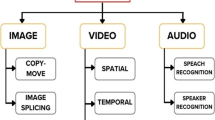Abstract
In this presentation, I will describe the motivating scenarios and applications for blind-passive media forensics (BPMF) technologies, contrasting them with conventional solutions that require adoption of end-to-end protocols or embedding of watermarks. BPMF methods verify the authenticity of the received content at the point of use by checking the integrity of features characteristic of the natural scenes or capturing devices, or the anomalies caused by the tampering operations. I will review the significant results achieved so far and discuss the direction for future research.
Similar content being viewed by others
References
Mitchell, W.J.: The Reconfigured Eye: Visual Truth in the Post-Photographic Era. MIT Press, Cambridge, Mass (1992)
YouWitnessNews (2006), http://news.yahoo.com/you-witness-news
Gavard, S.: Photo-graft: A critical analysis of image manipulation. MA Thesis, McGill University, Montreal, quebec (1999)
Baker, F.: Is Seeing Believing? A Resource For Educators (2004), http://www.med.sc.edu:1081/isb.htm
FakeorFoto, http://www.autodesk.com/eng/etc/fakeorfoto/quiz.html
Worth1000 Image Editing Contest Site, http://www.worth1000.com
Ng, T.T., Chang, S.F., Lin, C.Y., Sun, Q.: Passive-blind Image Forensics. In: Multimedia Security Technologies for Digital Rights, Elsvier, North-Holland (2006)
Author information
Authors and Affiliations
Editor information
Rights and permissions
Copyright information
© 2007 Springer Berlin Heidelberg
About this paper
Cite this paper
Chang, SF. (2007). Blind Passive Media Forensics: Motivation and Opportunity. In: Sebe, N., Liu, Y., Zhuang, Y., Huang, T.S. (eds) Multimedia Content Analysis and Mining. MCAM 2007. Lecture Notes in Computer Science, vol 4577. Springer, Berlin, Heidelberg. https://doi.org/10.1007/978-3-540-73417-8_11
Download citation
DOI: https://doi.org/10.1007/978-3-540-73417-8_11
Publisher Name: Springer, Berlin, Heidelberg
Print ISBN: 978-3-540-73416-1
Online ISBN: 978-3-540-73417-8
eBook Packages: Computer ScienceComputer Science (R0)




